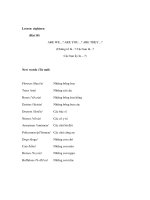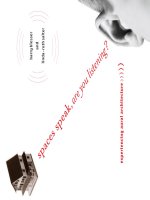spaces speak are you listening experiencing aural architecture dec 2006
Bạn đang xem bản rút gọn của tài liệu. Xem và tải ngay bản đầy đủ của tài liệu tại đây (2.95 MB, 453 trang )
Spaces Speak, Are You Listening?
Spaces Speak, Are You Listening?
Experiencing Aural Architecture
Barry Blesser and Linda-Ruth Salter
The MIT Press
Cambridge, Massachusetts
London, England
( 2007 Massachusetts Institute of Technology
All rights reserved. No part of this book may be reproduced in any form by any electronic or
mechanical means (including photocopying, recording, or information storage and retrieval)
without permission in writing from the publisher.
MIT Press books may be purchased at special quantity discounts for business or sales promotional
use. For information, please email or write to Special Sales Depart-
ment, The MIT Press, 55 Hayward Street, Cambridge, MA 02142.
This book was set in Stone Serif and Stone Sans on 3B2 by Asco Typesetters, Hong Kong and was
printed and bound in the United States of America.
Library of Congress Cataloging-in-Publication Data
Blesser, Barry.
Spaces speak, are you listening? : experiencing aural architecture / by Barry Blesser and Linda-Ruth
Salter.
p. cm.
Includes bibliographical references and index.
ISBN-13: 978-0-262-02605-5 (hc : alk. paper)
ISBN-10: 0-262-02605-8 (hc : alk. paper)
1. Space perception. 2. Auditory perception. 3. Architectural acoustics. 4. Psychoacoustics.
5. Sound—Recording and reproducing—Digital techniques. I. Salter, Linda-Ruth. II. Title.
QP443.B585 2006
612.8
0
5—dc22 2006044046
10987654321
Contents
Acknowledgments vii
A Personal Perspective ix
1 Introduction to Aural Architecture 1
2 Auditory Spatial Awareness 11
3 Aural Space from Prehistory to the Present 67
4 Aural Arts and Musical Spaces 127
5 Inventing Virtual Spaces for Music 163
6 Scientific Perspectives on Spatial Acoustics 215
7 Spatial Innovators and Their Private Agendas 275
8 Auditory Spatial Awareness as Evolutionary Artifact 317
9 Concluding Comments 361
Notes 365
References 369
Index 405
Acknowledgments
The book is based on the work of thousands of scientists, engineers, architects, schol-
ars, and researchers who created the intellectual foundation for aural architecture with-
out necessarily realizing that they were laying a foundation for this field. Without their
efforts, it would not have been possible to integrate and synthesize the enormous scope
of this subject into a coherent exposition.
I am especially grateful to my wife and best friend, Linda-Ruth Salter, for her un-
wavering encouragement during the four years that it took to write this book. As my
editor, critic, reviewer, and debating partner, she broadened and improved the text by
providing a social science perspective that complemented my scientific and engineer-
ing one. Because of her invaluable contributions throughout the project, I invited her
to be the second author. The ideas reflect a joint effort, spanning the 35 years of our
life together.
The insights and knowledge that I accumulated over the years came from a diverse
group of colleagues who taught me the power of intellectual collaboration, fusing a
broad range of abilities, experiences, and information into shared goals. Early in our
careers, both of us were influenced by two scholars who exemplified academic intellec-
tuals at their best: Murray Eden and Philip Kubzansky. More specific to the topic of au-
ral architecture, I acquired an appreciation for the subtleties of audio, perception, and
the aural arts through years of working with Karl Otto Ba
¨
der, Jan Wissmuller, David
Griesinger, and Geoff Steadman, all of whom have successfully integrated the aural
arts with modern technology.
During the many drafts of the manuscript, I learned that insight and analysis are use-
less if not clearly developed and well written. Many of my friends and colleagues spent
hundreds of hours editing drafts and teaching me the art of writing. For their valuable
contribution, I would like to express my appreciation to David Moran, David Moulton,
Jay Rose, Jean Sarris, and Shirley Reiss. As my editor at MIT Press, Doug Sery never
wavered in his faith that I would eventually convert an ill-defined proposal into a co-
herent book. Copy editor Jeff Lockridge greatly improved the flow, clarity, and organi-
zation of the writing, for which I am deeply grateful. Finally, my children, Andrew and
Sonya, provided emotional encouragement to continue with the project without
resenting the time that it took away from our family life. They, too, believed that this
project was worthwhile.
Looking back over the last four years, I have enjoyed the opportunity to work with
my truly great friends and colleagues, who gave freely of their time and ideas. I thank
them for their enthusiasm and their support. Though I served as the scribe, a large
community actually created this book.
viii Acknowledgments
A Personal Perspective
This book is my adventure story about transforming a narrow topic that has engaged
my professional interest for three decades into a set of broader issues. The story began
in the 1970s when I had the good fortune to develop and commercialize the first
digital signal-processing products for the recording industry: an audio delay and an
artificial reverberator. Now, more than a quarter century later, that technology has
expanded into a multibillion dollar industry permeating our culture and supporting
thousands of innovators making incremental contributions. Looking backward, it is
clear that my initial goal of electronically reproducing the auditory experience of a
concert hall had a much broader meaning than my initial concept. This book expands
that limited engineering goal into an interdisciplinary research project: the experience
of space by attentive listening. Like most of the thousands of people who have contrib-
uted to the aural architecture of spaces, I had not appreciated the artistic, social, histor-
ical, and philosophical context of my isolated activities.
The nature of a discussion depends on the scope of the questions being asked:
narrow or broad. I could have framed the discussion solely in terms of the physical
and mathematical properties of sound waves that contribute to the aural experience
of a concert hall. A vast body of literature already takes this approach. It is relevant
mainly for specialists who have the professional interest and necessary background
to appreciate the details of that subject. Rather, I have chosen to explore the broad phe-
nomenon of auditory spatial awareness without regard to a specific discipline, culture,
or time period. For me, the global approach is an intellectual adventure with gratifying
surprises.
What does it mean to explore a phenomenon? An explanation is never the phe-
nomenon itself, but only a refracted image of it, like looking at a scene through a
prism. Although models, theories, and pictures are not reality, they present aspects of
a phenomenon. For example, in dealing with musical space, a composer sees one
aspect of the phenomenon, whereas architects, archaeologists, anthropologists, audio
engineers, psychophysical scientists, and blind individuals each see other aspects.
When we have access to multiple views, each with its own biases and limitations, we
acquire greater understanding of the phenomenon. As we explore these views, we must
remember that each version of a phenomenon is always constrained by the questions
being asked and the answers being offered. On the other hand, the union of diverse
viewpoints, like multiple shadows from an object that we cannot see, allows us to
form an image of the phenomenon, which by definition always remains inaccessible.
While doing research for this book, I was frequently surprised by the relative igno-
rance of professionals about the issues and insights of other disciplines. I was also
unnerved by my own lack of useful knowledge about other disciplines. Yet with the
massive information overload in modern society, interdisciplinary explorations are
too inefficient without a guide to help navigate through the mountains of details.
Knowing of the existence of other disciplines is very different from extracting relevant
information from them. Interdisciplinary explorations of difficult problems are now
commonplace, but their varying degrees of success suggest that there are, as yet, no
clear answers to the questions of how or when to invest intellectual energy in such
activities. However revolutionary its possibilities, crossing into foreign disciplines
is still an ad hoc activity that is sometimes productive and sometimes irrelevant.
The pioneering work of Julie Thompson Klein (1990, 1996) and others on the prop-
erties of cross-disciplinary activities—interdisciplinarity—exemplifies the need for
structuring intellectual collaborations across disciplinary boundaries. However, until
interdisciplinarity become formalized, with proven predictive utility and methods,
cross-disciplinary works such as this one must be considered as experimental. I hope
that my efforts will illustrate the intellectual and professional utility that can result
from fusing fragmented viewpoints into a composite picture.
Had I been able to write this book decades ago, I would have managed my career
from a different perspective. I might have more accurately interpreted the pivotal
events that portended major paradigm shifts in my discipline. For example, I would
have seen the shift from solving an old engineering problem, artificially reproducing
concert hall acoustics, to inventing experiences without constructing buildings. I
would have recognized that artificial reverberation was a subset of musical space,
which itself is a subset of aural architecture, which depends on auditory spatial aware-
ness. None of these connections was apparent during my career. Unknowingly, I was a
member of an expanding generation of aural architects: electroacoustic designers who
were liberating auditory space from its physical roots. My own professional history
illustrates how I reacted to changes within my discipline without being aware of those
events that marked fundamental shifts.
Because, as one its many parents, I was present at the birth of the new discipline
of digital audio I had the opportunity to observe how it progressed from infancy to
adolescence, and then to maturity. During this progression, the original discipline
spawned new disciplines. Many died, but a few thrived to nurture a new generation
of disciplines. Although the original parents of digital audio are long retired, and al-
x A Personal Perspective
though their grandchildren are thriving, the attitudes of the current generation are still
strongly influenced by the values of their parents.
Aural architecture belongs within a family tree of disciplines having branches that
spread broadly across thousands of generations. The first marriage of visual and audi-
tory art occurred when paleolithic painters discovered that their paintings of hoofed
animals were more intense if they were located in caves producing echoes. Most impor-
tant, like biological evolution, aural architecture has its own rules for survival, muta-
tion, reproduction, and extinction.
Although the generations of artists, scientists, and engineers who contributed to
aural architecture built on the legacies of previous innovators, such legacies are often
taken as a given. Yet ignoring legacies does not reduce their impact. Indeed, innovative
behavior is itself a reaction to these powerful cultural forces. As much as I take pride
in having managed my own career, my activities were actually a response to cultural
shifts that elevated the importance of computer technology and audio entertainment
within the wider society.
Like our prehistoric ancestors who created wall paintings in resonant caves, my col-
leagues and I use available tools to create a listening experience for some personal and
social purpose. The nature of that experience remains rooted in inherited culture and
evolutionary biology. Although the supporting technology moves forward, the experi-
ence of aural architecture moves sideways in sweeping spirals. Even after having trav-
eled a long distance, we are not far from the core experience of all peoples. We cannot
discern the nature of that movement close-up. We need to take an aerial view to see
the larger picture.
As an intellectual travelogue, this book is my attempt to overcome an inadequate
education. I enjoyed the challenge of integrating and expanding a vast array of intel-
lectual fragments into a single, broad, and coherent theme: the experience of aural ar-
chitecture. I also included some speculations because the trip could not be completed
without also constructing bridges over the uncharted waters of unexplored topics and
missing research.
I take complete responsibility for any errors in fact and logic, and for any speculative
foolishness that leaked through the review process. Given the scope of this book, I
could not become an expert on the dozens of disciplines that are part of auditory spa-
tial awareness and its application to aural architecture. I hope other scholars will clarify
discussions that are either incomplete or debatable, thereby improving, correcting,
applying, and extending what is necessarily only a beginning.
A Personal Perspective xi
Spaces Speak, Are You Listening?
1 Introduction to Aural Architecture
We shape our buildings, and afterward our buildings shape us.
—Winston Churchill, 1943
Architecture, which has been called the ‘‘mother of all arts,’’ is concerned with the
design, arrangement, and manipulation of the physical properties of a space. Unlike
other art forms, architecture provides spaces for the daily activities of life; when more
than simply utilitarian, it also appeals to our aesthetic sensibilities. By choosing and
combining materials, colors, and shapes, architects embed their respective artistic mes-
sages in structures that we see, hear, and feel. Like poets with their specialized lan-
guage, architects communicate their worldview with a vocabulary of spatial elements
that often contain symbolic meaning reflecting their culture.
To communicate the artistic, social, emotional, and historical context of a space,
however, architects almost exclusively consider the visual aspects of a structure. Only
rarely do they consider the acoustic aspects. The native ability of human beings to
sense space by listening is rarely recognized; indeed, some people think such an ability
is unique to bats and dolphins. But sensing spatial attributes does not require special
skills—all human beings do it: a rudimentary spatial ability is a hardwired part of our
genetic inheritance. For example, when blindfolded, nearly all of us can approach a
wall without touching it just by attending to the way the wall changes the frequency
balance of the background noise. Similarly, the sounds of our footsteps hint at the
location of stairs, walls, low ceilings, and open doors. To make this more obvious,
walk through your home while listening to loud music through headphones; then do
it again without the headphones. Notice how the clear sounds of your shoes on uncar-
peted stairs provide navigational confidence, especially when your eyes are focused
elsewhere. When crawling through underground caves, spelunkers can gauge the
depth of a dark passageway by its resonances. But even nonspelunkers have acoustic
awareness. It is available to all of us.
Observing that ordinary people can hear passive objects and sense spatial geometry
requires an explanation. As a simple illustration of how we hear an object that itself
does not produce any sound, consider a flat wall located at some distance. When the
sound wave from a hand clap is reflected from that distant wall, we hear the reflection
as a discernible echo. The distance to the wall determines the delay for the arrival of
the echo, the area of the wall determines the intensity, and the material of the wall’s
surface determines the frequency content. These physical facts relate only indirectly
to perception. Our auditory cortex converts these physical attributes into perceptual
cues, which we then use to synthesize an experience of the external world. On the
one hand, we can simply hear the echo as an additional sound (sonic perception) in
the same way that we hear the original hand clap (sonic event). On the other hand,
we can interpret the echo as a wall (passive acoustic object). The echo is the aural
means by which we become aware of the wall and its properties, such as size, location,
and surface materials. The wall becomes audible, or rather, the wall has an audible
manifestation even though it is not itself the original source of sound energy. When
our ability to decode spatial attributes is sufficiently developed using a wide range of
acoustic cues, we can readily visualize objects and spatial geometry: we can ‘‘see’’ with
our ears.
A real environment, such as an urban street, a concert hall, or a dense jungle, is
sonically far more complex than a single wall. The composite of numerous surfaces,
objects, and geometries in a complicated environment creates an aural architecture.As
we hear how sounds from multiple sources interact with the various spatial elements,
we assign an identifiable personality to the aural architecture, in much the same way
we interpret an echo as the aural personality of a wall. To illustrate that we are aware
of aural architecture, consider displacing familiar sounds to unfamiliar environments.
Transported to an open desert, urban traffic would not have the aural personality of
a dense city environment. Moved to a forest, a symphony concert would not have
the aural impact, intimacy, and immediacy of a concert hall. Nor could the aural per-
sonality of singing in the bathroom, which takes advantage of the resonances of
small spaces, be duplicated in a large living room. In each contrasting space, even
if the sound sources were to remain unchanged, the aural architecture would change.
Every space has an aural architecture, which will be defined more extensively in chap-
ter 2.
In addition to providing acoustic cues that can be interpreted as objects and surfaces,
aural architecture can also influence our moods and associations. Although we may
not be consciously aware that aural architecture is itself a sensory stimulus, we react
to it. We may experience a living room as cold or warm independent of its actual tem-
perature, or a train station as lonely and forbidding independent of its actual appear-
ance. The acoustics of a grand cathedral can create an exalted mood; those of a chapel
can enhance the privacy of quiet contemplation; those of an elevator can produce the
feeling of encapsulation and, in the extreme, claustrophobia. The acoustics of an open
area can produce feelings of either freedom or insecurity.
2 Chapter 1
Aural architecture can also have a social meaning. For example, the bare marble
floors and walls of an office lobby loudly announce the arrival of visitors by the re-
sounding echoes of their footsteps. In contrast, thick carpeting, upholstered furniture,
and heavy draperies, all of which suppress incident or reflected sounds, would mute
that announcement. The aural architecture of the lobby thus determines whether
entering is a public or private event. When applied to a living room, those same acous-
tic attributes convey a different sense: cold, hard, and barren, as contrasted with warm,
soft, and intimate. In a musical performance space, acoustic attributes can produce a
blending of sequential notes, almost like chords. In certain religious spaces, they can
produce a reverberation that conveys a sense of awe and reverence. As with all sensory
aspects of architecture, cultural values and social functions determine the experiential
consequences of spatial attributes. In different social settings, the same acoustic fea-
tures have different meanings, which then influence the mood and behavior of the
people in those settings.
Aural architecture, with its own beauty, aesthetics, and symbolism, parallels visual
architecture. Visual and aural meanings often align and reinforce each other. For
example, the visual vastness of a cathedral communicates through the eyes, while its
enveloping reverberation communicates through the ears. For those with ardent reli-
gious beliefs, both senses create a feeling of being in the earthly home of their deity.
Similarly, the visual elegance of a grand opera hall contributes to the artistry of the per-
formance, and the aura of power in a governmental chamber contributes to the impor-
tance of speeches presented there. In these examples, because the aural and visual
elements in the space are congruent, symbols and associations are shared.
Although we expect the visual and aural experience of a space to be mutually sup-
portive, this is not always the case. Consider dining at an expensive restaurant whose
decorations evoke a sense of relaxed and pampered elegance, but whose reverberating
clatter produces stress, anxiety, isolation, and psychological tension, undermining the
possibility of easy social exchange. The visual and aural attributes produce a conflicting
response.
1
Although multiple senses contribute to the formation of an internal experience of an
external reality, the contribution made by listening varies greatly among individuals
and cultures (Classen, 1993). Since listening with understanding depends on culture,
rather than on the biology of hearing, auditory spatial awareness must be considered
the province of sensory anthropology. To evaluate aural architecture in its cultural con-
text, we must ascertain how acoustic attributes are perceived: by whom, under what
conditions, for what purposes, and with what meanings. Understanding aural architec-
ture requires an acceptance of the cultural relativism for all sensory experiences.
Sensory anthropology studies how social structures determine the use of the senses
and the meaning of the resulting perceptions (Howes, 1991). In our scientific society
with its emphasis on physical explanations, the categories for sensing the external
Introduction to Aural Architecture 3
world are mostly sorted by the combination of biological organs and physical stimuli:
ears are for hearing sound, eyes are for seeing light, and skin is for touching surfaces
(Ackerman, 1990). Yet even with this bias toward concrete labeling, our culture takes
no notice of the many different kinds of information processing that actually compose
a single sensory modality. For example, the tactile modality—touch—includes inde-
pendent sensors for vibration, texture, temperature, movement, and so on. Our very
concept of the senses arises from our cultural biases.
To illustrate the wide range of choices for labeling the senses and for understanding
their relationship to social functions, consider a few examples from other cultures and
subcultures. The Hausa people recognize only two senses: seeing and experiencing
(Ritchie, 1991). In this culture, the vision sense is only a means for navigating the en-
vironment, and the experience sense encompasses intuition, emotion, smell, touch,
taste, and hearing. The anthropologist Anthony Seeger (1981), in addressing cultural
meaning of sensation, commented: ‘‘Just as time and space are not perceived by the
vast majority of human societies as a regular continuum and grid, so the [sensorium]
is rarely thought of in strictly biological terms. . . . The five senses are given different
emphasis and different meanings in different societies. A certain sense may be privi-
leged as a sensory mode.’’ For example, Aivilik Eskimo natives do not describe space
in visual terms (Carpenter, 1955) because their environment is an open expanse with-
out visual markers. For this group, the nonvisual senses play a stronger role in their ex-
perience of space. Similarly, in many religious subcultures, their gods speak to their
disciples rather than leave them written messages. Rehabilitation workers often report
that blindness is less socially and emotionally burdensome than deafness. Some cul-
tures revere the role of the blind seer who has learned to accentuate the gift of listening
as a better means for ‘‘seeing’’ the future.
From this broad perspective, it is clear that hearing contributes to a wide range of
experiences and functions. Hearing, together with its active complement, listening, is
a means by which we sense the events of life, aurally visualize spatial geometry, propa-
gate cultural symbols, stimulate emotions, communicate aural information, experience
the movement of time, build social relationships, and retain a memory of experiences.
To a significant but underappreciated degree, aural architecture influences all of these
functions.
Let us digress briefly to clarify a few common words and concepts relating to sound.
Over the years, some words have acquired meanings and associations that deviate
from their dictionary definitions. Acoustics, from the Greek akoustikos and meaning
that which pertains to hearing, now refers mostly to the behavior of sound waves
(vibrations) in solids, liquids, or gases. Listening is not required, and may not even
be possible, for underwater, ultrasonic, or high-pressure acoustics. Even when listen-
ing is expected, acoustic architecture uses the language of physics to describe sonic
4 Chapter 1
processes as phenomena that can be measured. To clarify how key terms are used
in this book, the adjective aural, which parallels visual, refers exclusively to the human
experience of a sonic process; hearing, to the detection of sound; and listening, to active
attention or reaction to the meaning, emotions, and symbolism contained within
sound.
Accordingly, aural architecture refers to the properties of a space that can be experi-
enced by listening. An aural architect, acting as both an artist and a social engineer, is
therefore someone who selects specific aural attributes of a space based on what is de-
sirable in a particular cultural framework. With skill and knowledge, an aural architect
can create a space that induces such feelings as exhilaration, contemplative tranquil-
lity, heightened arousal, or a harmonious and mystical connection to the cosmos. An
aural architect can create a space that encourages or discourages social cohesion among
its inhabitants. In describing the aural attributes of a space, an aural architect uses
a language, sometimes ambiguous, derived from the values, concepts, symbols, and
vocabulary of a particular culture.
In contrast, an acoustic architect is a builder, engineer, or physical scientist who
implements the aural attributes previously selected by an aural architect. Acoustic
design manipulates physical objects, spatial geometries, and mathematical equations
using the scientific language of physics. Because of differences in their perspectives,
acoustic architects focus on the way that the space changes the physical properties of
sound waves (spatial acoustics), whereas aural architects focus on the way that listeners
experience the space (cultural acoustics). Although some individuals function as both
aural and acoustic architects, the fundamental difference in the two functions is the
distinction between choosing aural attributes and implementing a space with previ-
ously defined attributes.
We can sometimes identify the aural architect of a space, but far more frequently,
aural architecture is the incidental consequence of unrelated sociocultural forces. An-
cient cathedrals possess an aural architecture, without having had aural architects.
Towns have an aural architecture that arises from their natural geography and to-
pography, as well as from the uncoordinated construction of streets and buildings.
Residential dwellings have an aural architecture determined by design traditions and
construction budgets. The aural architecture of many modern spaces is created by
architects, space planners, and interior designers with little appreciation for the aural
impact of their choices. Living rooms, restaurants, and automobiles are examples of
such spaces. Aural architecture thus exists regardless of how the acoustic attributes of
a space came into existence: naturally, incidentally, unwittingly, or intentionally. For
these reasons, the aural architect is most often not an actual person.
Even when the architects are actual people, however, aural architecture is not the
exclusive domain of a handful of acoustic professionals who have an opportunity to
Introduction to Aural Architecture 5
design classrooms, concert halls, or churches. In a very real sense, we are all aural archi-
tects. We function as aural architects when we select a seat at a restaurant, organize a
living space, or position loudspeakers.
To broaden the concept still further, aural architecture includes the creation of
spatial experiences where a physical space does not actually exist, so-called virtual,
phantom, and illusory spaces. While listening to recorded music in our homes, we ex-
perience a virtual space created by a mixing engineer who manipulated a spatial syn-
thesizer in a recording studio. There never was a performance space. Defined as the
design or selection of a spatial experience, without regard to the means of implement-
ing that experience, aural architecture is as old as civilization, embracing the widest di-
versity of social and artistic examples in cultures that span thousands of years.
Even though aural architects are most often sociocultural forces rather than actual
people, we can still examine how these forces influence spatial designs. Over the mil-
lennia, a series of progressive changes in the relationship between aural architecture
and its social uses resulted from changes in artistic attitudes, in the prevailing theol-
ogy, and in how the senses were used to experience physical and social environments.
The difference between adapting a cave for a religious ceremony and designing a con-
sumer home theater surround-sound system reflects not only advances in technology,
but also changes in culture. Those who built cathedrals and those who designed virtual
electroacoustic spaces were seldom aware of how their social context influenced their
spatial creations.
Thousands of visual artists, civil engineers, architectural historians, and social scien-
tists have created a comprehensive symbolic language and an extensive literature for
visual architecture, whose intellectual foundation draws on archaeology, engineering,
history, sociology, anthropology, evolution, psychology, and science. In contrast, even
though aural architecture shares the same intellectual foundation, its language and lit-
erature are sparse, fragmented, and embryonic.
There are four principal reasons why this might be so. First, aural experiences of
space are fleeting, and we lack means for storing their cultural and intellectual legacy
in museums, journals, and archives. Second, for both cultural and biological reasons,
the language for describing sound is weak and inadequate. Third, being fundamentally
oriented toward visual communications, modern culture has little appreciation for the
emotional importance of hearing, and thus attaches little value to the art of auditory
spatial awareness. And fourth, questions about aural architecture are not generally rec-
ognized as a legitimate domain for intellectual inquiry; professional schools provide
little or no training in physical acoustics, aural aesthetics, or sensory sociology.
Because aural architecture is not a recognized discipline, its concepts are not a signif-
icant part of our cultural and intellectual mainstream. When professional architects
focus exclusively on the visual and utilitarian attributes of a space, they are reflecting
6 Chapter 1
a tradition that devalues listening. More significant, when listeners tolerate an environ-
ment whose acoustics damage their ears, their social relations, or both, they, too, are
devaluing the aural experience.
There are, however, segments of our culture that take an interest in aural architec-
ture. When given the freedom to choose the aural attributes of a spatial experience, au-
dio engineers, composers, acoustic scientists, and spatial designers function as aural
architects. There are conspicuous and representative examples of artists and architects
who explicitly focus on aural architecture. The Finnish architect Juhani Pallasmaa
(1996), who rejected the assumption of visual dominance, considered sensory architec-
ture as an umbrella theme that explicitly included aural architecture. R. Murray Schafer
(1977), in formulating the concept of the soundscape as a mixture of aural architecture
and sound sources, created disciples who have passionately extended and applied his
initial concept. Thomas Sheridan and Karen van Lengen (2003) argued that architec-
tural schools should intentionally include aural considerations in order ‘‘to achieve
a richer, more satisfying built environment.’’ In their treatise on spatial acoustics,
Hope Bagenal and Alex Wood (1931) recognized the social and cultural aspects of aural
architecture.
The aural architecture of musical spaces, unlike that of religious, political, and social
spaces, is well recognized and extensively researched. When a musical space is consid-
ered to be an extension of musical instruments, rather than an independent manifesta-
tion of aural architecture, it becomes a tool to be used by composers, musicians, and
conductors. Musical spaces are intentionally designed for specific audiences that have
acquired sensitivity and appreciation for spatial acoustics, as these bear on their experi-
ence of music and voice. Musical spaces are also an interesting application of aural
architecture because music has played a role far beyond that of entertainment, a role
anchored in history, culture, evolution, and neurobiology. Like architecture, music is
also a language of aesthetics, spirituality, patriotism, and especially the emotions of
joy, love, pride, and sorrow. Although they do not identify themselves as such, many
aural architects are found within audio and musical subcultures. Fortunately, we can
apply our knowledge of musical spaces to other kinds of space as well.
Even within a given culture, listeners are not homogeneous with regard to how they
use their sense of hearing. When, however, listeners share a similar relationship to
some aspect of aural architecture, they become a relatively homogeneous group, an
auditory subculture. We find auditory subcultures both within a culture and across cul-
tures. Active users of particular kinds of acoustic space who share goals, motivation, ge-
netic ability, and opportunities often become a unique auditory subculture. They teach
themselves to attend to the particular spatial attributes they consider important. From
this perspective, those with an active interest in music—performers, composers, and
listeners—form an auditory subculture with an enhanced sensitivity to the aspects of
Introduction to Aural Architecture 7
aural architecture that apply to their music. Those blind individuals who orient and
navigate a space by listening to objects and geometries form another auditory sub-
culture. The experience of aural architecture depends on the individual’s subculture.
A related kind of social grouping is the professional subculture whose members
study, design, or manipulate spatial attributes for the purpose of creating aural experi-
ences for others. Often these professionals do not realize they are functioning as aural
architects. To name but a few, such subcultures include ancient shamans who per-
formed ceremonies in caves, recording engineers who use virtual space simulators as
part of the production process, cinema film directors who match or contrast the visual
and auditory experience of space, social psychologists who study human behavior, and
designers of religious ceremonial spaces who want the congregation to feel a connec-
tion with their deities and their heavenly cosmos. Each of these professional sub-
cultures is unique in terms of its educational training, cultural beliefs, specialized
goals, economic rewards, and private agendas. Aural architecture is mostly the result
of the values and biases in these professional subcultures.
In one sense, the concept of aural architecture is nothing more than an intellectual
edifice built from bricks of knowledge, borrowed from dozens of disciplinary sub-
cultures and thousands of scholars and researchers. I did not create these bricks, all of
which appear in published papers. When fused together into a single concept, how-
ever, the marriage of aural architecture and auditory spatial awareness provides a way
to explore our aural connection to the spaces built by humans and to those provided
us by nature. This book is the story of that marriage over the centuries in a variety of
cultures and subcultures, and today’s artists and scientists are its children.
Individuals who use spaces for a particular purpose, and individuals who design
spaces for a particular use, often acquire a heightened sensitivity to particular aspects
of aural architecture. Auditory spatial awareness is a multiplicity of related but inde-
pendent abilities. Although evolution provided our species with the basic neurobiology
for hearing space, each sensory and professional subculture emphasizes only a subset
of this endowment. Conversely, those who are neither users nor designers of aural
architecture are unlikely to display more than the basic abilities to hear space. Further-
more, cultures without any appreciation for aural experiences are unlikely to develop
and support those subcultures with an interest in aural architecture.
Spaces Speak is written for three types of reader. First, for those professionals who
possess an expertise in one of the supporting disciplines, the discussions provide an
overview into related, and possibly unfamiliar, areas. Second, for those with a general
curiosity, the discussion integrates the collective knowledge of many artists, designers,
and scientists into an accessible presentation of aural architecture. And finally, for
those with a love of music, the discussions explore aural architecture as an extension
of the auditory arts.
8 Chapter 1
As an intellectual mosaic, Spaces Speak explores auditory spatial awareness and its
relationship to aural architecture. Discussions move from cave acoustics to home the-
ater audio systems, from evolution to neurobiology, from physics to perception, from
science to engineering, from physical to virtual spaces, and from physical sound to
emotional response. This book does not require expertise in any of the relevant special-
ties, and it will not make its readers experts. Rather, it is intended to provide a means
of capturing and fusing disparate knowledge into a common framework: the human
condition as seen through one particular prism, the aural architecture of spaces.
Introduction to Aural Architecture 9









